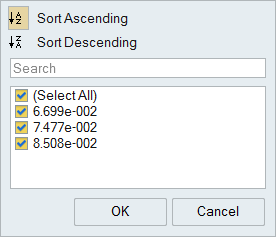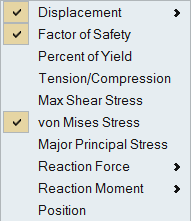Show Motion Analysis Results
Use the Show Motion Analysis Results tool to view the results of a motion part analysis in the Analysis Explorer. View and animate results, add callouts, and compare results from different runs.
-
Click the Show Motion Analysis Results tool on the
Analyze Part icon.

Tip: To find and open a tool, press Ctrl+F. For more information, see Find and Search for Tools.The Analysis Explorer is displayed.
- Select the Run you want to view.
- Select a Load Case.
- Select the Result Type you want to view.
- Use the additional options to animate the result, change what is shown in the modeling view, create callouts, and compare results.
- Right-click or press Esc to close the Analysis Explorer and return to the original part.
- The results from the motion part analysis are consolidated into a single entity known as the Combined Motion Load Case.
- The Result Envelope shows the maximum value for each result type across the combined motion load case.
Animation Toolbar
Use the animation toolbar to play, record, and configure the animation.

- Animation Settings
- Click to open the Animation Settings.
- Play and Record/Stop Recording
- Click the button to begin recording the results; the icon changes to red to indicate that it is recording. Click the icon again to stop recording.
- Start Animation/Pause Animation
- Click the button to start or pause the animation. Use the arrow buttons to jump the first or last frame in the animation.
- Move to First/Previous/Next/Last Step
- These buttons allow you to step through the animation frame-by-frame. If you hold down the Previous or Next button, it will auto-repeat. If you want to skip frames, use the Increment By feature in the Animation Settings; hold Ctrl to temporarily override this behavior.
- Slider
- Drag the slider on the toolbar to view a particular point during the analysis; use the arrow keys to move frame-by-frame through the animation.
- Current Step
- Displays the current time or frame. You can also enter a value to go to the nearest time/frame.
- Make Current Frame the New Design Position
- Click to use the current position of the mechanism as the model's starting point for the next run. This option is only avaiable for motion analysis.
- Plot Manager
- Open the Plot Manager to browse and plot motion results data, create cross plots (data vs. data), define pages in different layouts, and save the plots you've defined as a template for reuse. This option is only avaiable for motion analysis.
- Display Linear Modes Table
- Open the Linear Modes table to view the results of a linear analysis in complex number form with natural frequencies and damping ratio. This option is only avaiable for linear motion analysis.
Animation Options
The animation options on the Analysis Explorer allow you to start and stop the animation and adjust basic settings.
| Option | Description | |
|---|---|---|
| Play/Stop Animation |  |
Animate the selected result. |
| Animation Speed | Change the speed of the animation. | |
| Scale by | Change the scale of the animation. Generally the scale of a displacement is too small to see clearly, so auto scaling is enabled by default. This option is only available for structural results, not motion results. | |
Show Options
Determine what is made visible in the modeling window when viewing analysis results. You can show or hide the initial shape, loads and supports, deformation, and/or contours.
| Option | Description | Note | |
|---|---|---|---|
| Show/Hide Initial Shape | Show/hide the initial shape as a reference. | ||
| Show/Hide All Loads and Supports | Show/hide loads and supports. You can also show only the current loads and supports. | ||
| Show/Hide Deformed State | Show/hide the deformed shape as a reference. | ||
| Show/Hide Contours | Show/hide contours. | ||
| Options |
|
||
| Show/Hide Elements | Show/hide the element edges. | This icon appears under the view controls in the lower left of the modeling window, but only when the Analysis Explorer is active. | |
Add Callouts to the Results
Call out and review values for a selected result type at points of interest on your model using the callout icons in the Analysis Explorer.
- Select the Show Analysis Results tool on the Analyze icon, if not already active.
-
To create a callout at a point of interest, click
 in the Analysis Explorer, select a
Result Type, and then click a point on your model.
Box-select to see the maximum value in an area.
Note: The callout value applies to the currently selected run and load case.
in the Analysis Explorer, select a
Result Type, and then click a point on your model.
Box-select to see the maximum value in an area.
Note: The callout value applies to the currently selected run and load case. -
To automatically create callouts showing where the minimum and maximum values
occur for a result type, select a Result Type, and then
click
 .
Note: When you select Factor of Safety for the result type, the minimum is shown.
.
Note: When you select Factor of Safety for the result type, the minimum is shown. - Optional:
To display callouts in a table, click
 in the Analysis Explorer.
Each callout is specific to a selected run.
In Inspire, it is also
specific to the selected load case.
in the Analysis Explorer.
Each callout is specific to a selected run.
In Inspire, it is also
specific to the selected load case.

- Selecting a row in the table also selects the callout in the modeling window.
- To show or hide a single callout, in the Callouts table, Name column,
click
 .
. - To show or hide all callouts, in the Analysis Explorer, click
 .
. - To sort the order of a column in the table, click the column header. Or
you can click
 or
or  to select Sort
Ascending or Sort Descending.
to select Sort
Ascending or Sort Descending.
- To add or delete columns on the table, right-click a column header, and
then select or deselect a property.

- Optional: For motion part analysis results, click the Plot button to display time history plots for callouts defined for structural analysis. Changes made to the Result Types option are synchronized with the setting on the Analysis Explorer. Using this option allows you to put multiple plots of mixed types on a single page.
Compare Results
Compare the results of multiple analysis runs in a table. The Compare Results button is located at the bottom of the Analysis Explorer.
For analysis, you can compare results across all runs and load cases for the selected result type. You can also compare result types at a point of interest where you have placed a callout.
-
Select the Show Analysis
Results tool on the Analyze icon, if
not already active.On the Motion
ribbon, select the Review Flexible Body Results
tool.

Tip: To find and open a tool, press Ctrl+F. For more information, see Find and Search for Tools. -
Click the Compare Results button located at the bottom
of the Analysis Explorer.

The table for comparing results appears at the bottom of the modeling window.
-
Select the row to display the results for that run and load case.
- Double-click a cell in the table to show that result in the modeling window.
- Click the chevron next to the table title to select a different result type or a callout.
- Click the chevron on a column header to filter results.
- Click a column header to sort the column.
- Right-click a column header to change what result types, run parameters, or callouts are shown in the table.
- Click the top left corner of the table to copy the contents of all cells. This can then be pasted into Excel.
Additional columns can be added to show additional result types and parameters from the Run Analysis window. The red-blue color bands correspond to the legend in the Analysis Explorer; the width of the band indicates the magnitude of the result. Changes to the upper and lower bound in the Analysis Explorer are automatically reflected in the Compare Analysis Results table.